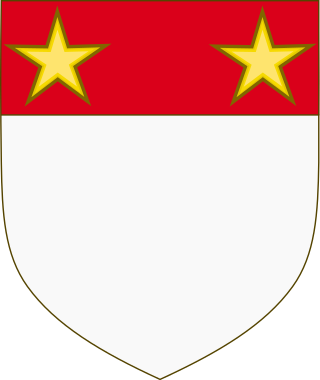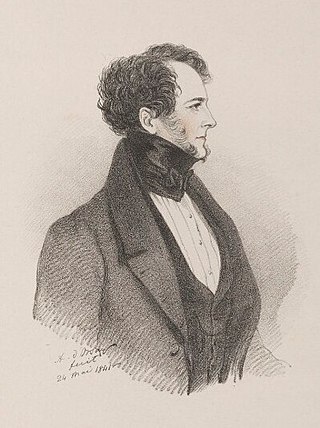
Marquess of Winchester is a title in the Peerage of England that was created in 1551 for the prominent statesman William Paulet, 1st Earl of Wiltshire. It is the oldest of six surviving English marquessates; therefore its holder is considered the premier marquess of England. It is also now the only marquessate in the Peerage of England not being subsidiary to a higher title. The current holder is Christopher Paulet, 19th Marquess of Winchester, whose son uses the courtesy title Earl of Wiltshire.

Baron Hastings is a title that has been created three times. The first creation was in the Peerage of England in 1290, and is extant. The second creation was in the Peerage of England in 1299, and became extinct on the death of the first holder in c. 1314. The third creation was in the Peerage of England in 1461, and has been in abeyance since 1960.

Baron FitzWalter is an ancient title in the Peerage of England. It was created on 24 June 1295 for Robert FitzWalter. The title was created by writ, which means that it can descend through both male and female lines.

Baron St John of Bletso, in the County of Bedford, is a title in the Peerage of England. It was created in 1582 for Oliver St John.

Viscount Bolingbroke is a current title in the Peerage of Great Britain created in 1712 for Henry St John. He was simultaneously made Baron St John, of Lydiard Tregoze in the County of Wilts. Since 1751, the titles are merged with the titles of Viscount St John and Baron St John in the same peerage.

Lord Polwarth, of Polwarth in the County of Berwick, is a title in the Peerage of Scotland. It was created in 1690 for Sir Patrick Hume of Polwarth, 2nd Baronet, Lord Chancellor of Scotland from 1696 to 1702. In 1697 he was further created Lord Polwarth, of Polwarth, Redbraes and Greenlaw, Viscount of Blasonberrie and Earl of Marchmont, also in the Peerage of Scotland. Upon the death of his grandson, the third Earl, the creations of 1697 became dormant (unclaimed).

There have been three baronetcies created for persons with the surname Croft, one in the Baronetage of England and two in the Baronetage of the United Kingdom. All three creations are extant as of 2008.

There have been two baronetcies created for members of the Trevelyan family, one in the Baronetage of England and one in the Baronetage of the United Kingdom. As of 2014, both creations are extant.

There have been four baronetcies created for persons with the surname Hope, three in the Baronetage of Nova Scotia and one in the Baronetage of the United Kingdom. As of 2010 one creation is extant, one dormant and two extinct.
Three baronetcies were created for persons with the surname D'Oyly, two in the Baronetage of England and one in the Baronetage of the United Kingdom. One creation is extant as of 2008.
There have been four baronetcies created for persons with the surname O'Brien, one in the Baronetage of Ireland and three in the Baronetage of the United Kingdom.
There have been two baronetcies created for persons with the surname Mackworth, one in the Baronetage of England and one in the Baronetage of Great Britain. One creation is extant as of 2008.
The Vyvyan Baronetcy of Trelowarren, Cornwall is a title in the Baronetage of England. It was created on 12 February 1645 for Richard Vyvyan, a member of Parliament for Penrhyn, Tregony and St Mawes and Master of the Mint. His eldest son, the second Baronet, represented St Mawes and Helston in the House of Commons. He was succeeded in 1697 by his son, the third Baronet, was a member of Parliament for Mitchell and Cornwall and a prominent Jacobite. The eighth Baronet sat as Conservative Member of Parliament for Cornwall, Okehampton, Bristol and Helston. His grandson, the tenth Baronet, was a Colonel in the British Army. As of 28 February 2014, the present Baronet has not successfully proven his succession and is therefore not on the Official Roll of the Baronetage, with the baronetcy considered dormant since 1995.
There have been four baronetcies created for members of the Thorold family of Lincolnshire, two in the Baronetage of England and two in the Baronetage of Great Britain. As of 2014 one creation is extant.

There have been three baronetcies created for persons with the surname Carew, two in the Baronetage of England prior to 1707, one in the Baronetage of Great Britain.
There have been four baronetcies created for people with the surname Innes, three in the Baronetage of Nova Scotia and one in the Baronetage of the United Kingdom. Three of the creations are extant as of 2010.
There have been two baronetcies created for persons with the surname Mildmay, one in the Baronetage of England and one in the Baronetage of Great Britain. Both are extinct.

Sir Henry Paulet St John-Mildmay, 3rd Baronet, of Dogmersfield Park, Hampshire, was an English politician.

Sir Henry St John Carew St John-Mildmay, 4th Baronet, of Dogmersfield Park, Hampshire, was an English politician.
Paulet St John-Mildmay was an English Whig Party politician. He sat in the House of Commons as a Member of Parliament (MP) for Winchester from 1818 to 1835, and from 1837 to 1841.










